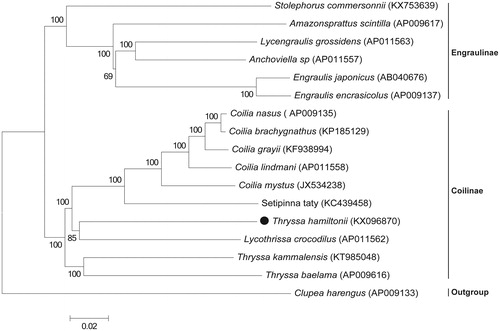Abstract
This study aimed to elucidate the complete mitochondrial genome (mitogenome) of Thryssa hamiltonii (Clupeiformes: Engraulidae). The circular mitogenome is 16,737-bp-long, including 13 protein-coding genes, 22 tRNA genes, two rRNA genes, and a non-coding control region as observed in other vertebrates. The overall base composition is as follows: A, 30.69%; T, 24.86%; C, 28.17%; G, 16.29%; a slight A + T bias of 55.55%. Phylogenetic analysis of 16 species in family Engraulidae revealed that T. hamiltonii clustered in subfamily Engraulinae and is closely related to Lycothrissa crocodilus. The present data will contribute to future phylogenetic studies on members of family Engraulidae and conservation strategies for T. hamiltonii.
Thryssa hamiltonii, family Engraulidae, is distributed throughout the tropical western Indo-Pacific region and plays an important role in marine biodiversity and recovery of fishery resources; its deteriorating resources have attracted increasing attention (Qin et al. Citation2011). The mitochondrial genome is an effective tool for species identification, molecular taxonomy, and population genetic analyses (Galtier et al. Citation2009). Therefore, the complete mitochondrial genome of T. hamiltonii and its phylogenetic relationships within Engraulidae were investigated in this study. The results of this study may contribute to phylogenetic analyses of the members of family Engraulidae and further conservation strategies for T. hamiltonii.
The specimen was collected from the South China Sea (21°88′N, 113°18′E). Muscle was sampled and frozen in liquid nitrogen and then stored at −80 °C in South China Sea Fisheries Research Institute, Guangzhou, China. Mitochondrial DNA (mtDNA) was isolated using a Mitochondrial DNA Isolation Kit (Haling Biotech Shanghai, Co., Ltd, Shanghai, China). Whole-genome sequencing was performed using the Illumina HiSeq 2500 Sequencing System (Illumina, Inc). Clean data were assembled by the SOAPdenovo Assembler program (v.2.04) and GapCloser (v.1.12) (Beijing Genomics Institute, China), and the assembled mtDNA was assessed via polymerase chain reaction. The tRNA genes were identified using tRNAscan-SE 2.0 (Lowe & Chan, Citation2016). Maximum Likelihood (ML) trees were constructed using MEGA6.06 software based on complete mitochondrial genomes of species in family Engraulidae (Tamura et al. Citation2013).
The complete mitochondrial genome of T. hamiltonii (GeneBank accession number KX096870) is 16,737-bp-long and contains 13 protein-coding genes (PCGs), 22 tRNA genes, 2 rRNA genes, and a control region (D-loop) (). The overall base composition of the mitogenome is the following: A, 30.69%; T, 24.86%; C, 28.17%; G, 16.29% G; a slight A + T bias of 55.55%, conserved in other species in family Engraulidae (Wang et al. Citation2015; Zhang and Gao Citation2016). Most genes are encoded on the heavy strand, except ND6 and eight tRNA genes (tRNA-Gln, tRNA-Ala, tRNA-Asn, tRNA-Cys, tRNA-Tyr, tRNA-Ser(UCA), tRNA-Glu, and tRNA-Pro), which are encoded on the light strand. All PCGs initiate with ATG as the start codon, except for COX1 (GTG). This is common in vertebrate mtDNA (Wang et al. Citation2018). Five PCGs (ND1, COX1, ATPase8, ATPase6, and ND4L) typically terminate with TAA as the stop codon; however, ND6 ends with AGG. Five PCGs (ND2, COX2, ND3, ND4, and Cyt b) end with T–, and ND5 ends with TA–. Twenty-two tRNA genes, 66–76 bp, display a typical clover-leaf secondary structure, except for tRNA-Ser(AGC). The control region, with high A + T content (61.19%), is located between tRNA-Pro and tRNA-Phe.
Table 1. Features of the mitochondrial genome of Thryssa hamiltonii.
To elucidate the phylogenetic position of T. hamiltonii, a ML phylogenetic tree was constructed with 16 species in family Engraulidae based on their complete mitogenome (); it clearly shows that the species in family Engraulidae are divided into two subfamilies, Engraulinae and Coilinae, and T. hamiltonii is clustered in subfamily Engraulinae and closely related to Lycothrissa crocodilus. The present data may potentially contribute to taxonomic and phylogenetic studies of members of the family Engraulidae and further conservation strategies for T. hamiltonii.
Disclosure statement
The authors report no conflicts of interest. The authors alone are responsible for the content and writing of the paper.
Additional information
Funding
References
- Galtier N, Nabholz B, Glemin S, Hurst GDD. 2009. Mitochondrial DNA as a marker of molecular diversity: a reappraisal. Mol Ecol. 18:4541–4550.
- Lowe TM, Chan PP. 2016. tRNAscan-SE On-line: integrating search and context for analysis of transfer RNA genes. Nucleic Acids Res. 44:54–57.
- Qin JF, Chen HG, Cai WG, Yang T, Jia XP. 2011. Effect of di-n-butyl phthalate (DBP) on biochemistry indicators of Thryssa hamiltonii. South China Fisheries Sci. 7:29–34.
- Tamura K, Stecher G, Peterson D, Filipski A, Kumar S. 2013. MEGA6: Molecular evolutionary genetics analysis version 6.0. Mol Biol Evol. 30:2725–2729.
- Wang PF, Zhao C, Fan SG, Yan LL, Qiu LH. 2018. Characterization and phylogenetic analysis of the complete mitochondrial genome of Glossogobius giuris (Perciformes: Gobiidae) Mitochondrial DNA Part B. 3:395–396.
- Wang SH, Wang BH, Hu ML, Wang F, Wu ZQ. 2015. The complete mitochondrial genome of Coilia brachygnathus (Clupeiformes: Engraulidae: Coilinae). Mitochondrial DNA Part A. 27:4084–4085.
- Zhang J, Gao TX. 2016. The complete mitochondrial genome of Thryssa kammalensis (Clupeiformes_ Engraulidae). Mitochondrial DNA Part B. 1:12–13.

